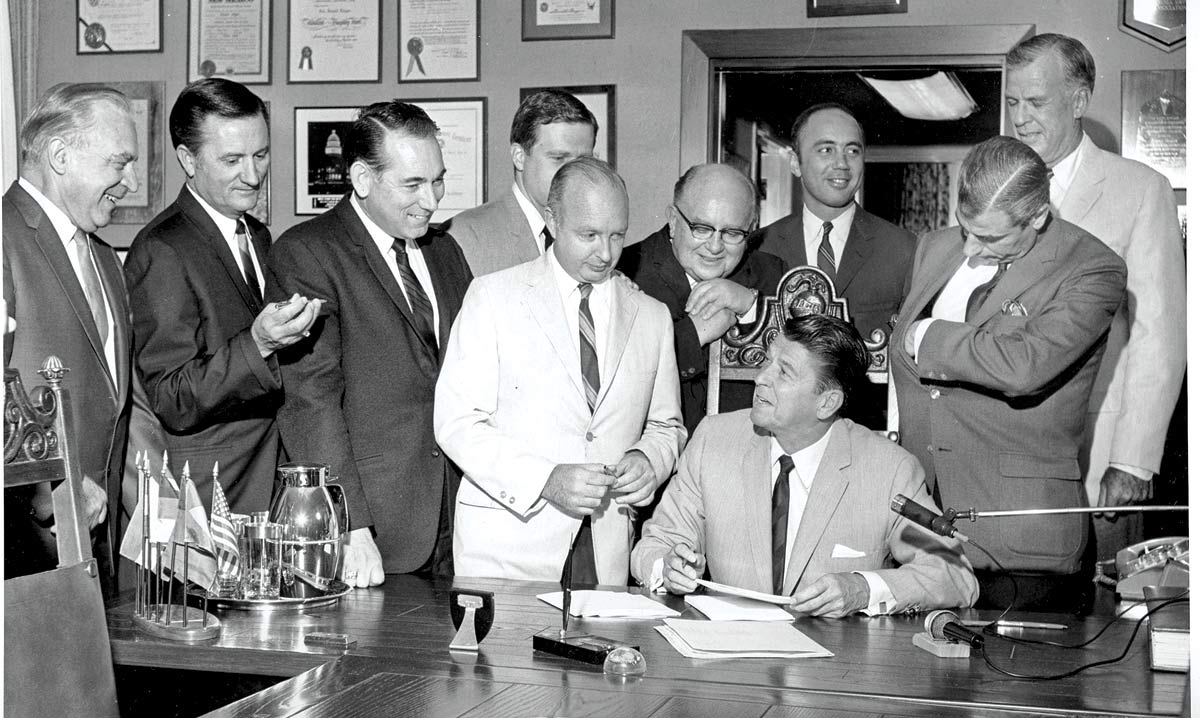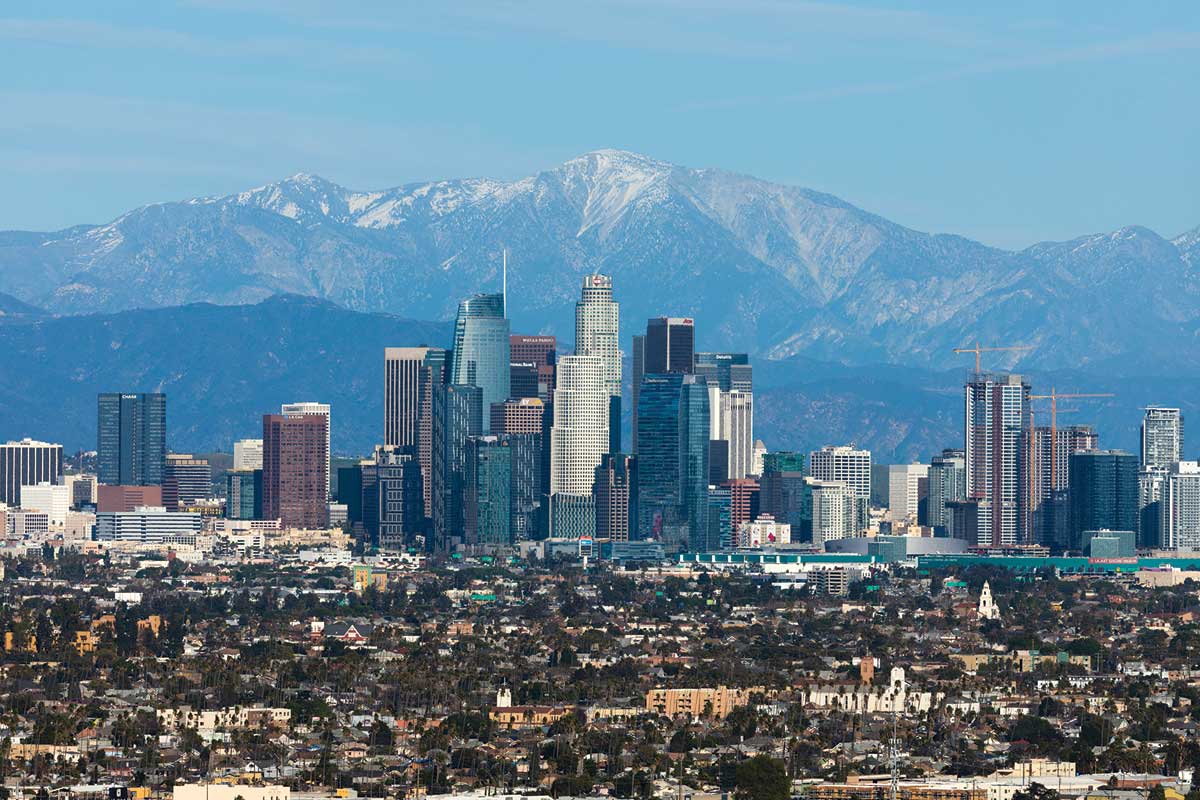Fifty years ago, when the Nixon administration and Congress were working to strengthen the Clean Air Act, they looked to California to see how it could be done. In tackling the Los Angeles area’s awful smog, state officials had already established emissions standards for vehicles, mandating the use of cutting-edge technology like crankcases that recirculate exhaust into the emissions system rather than simply spew it into the air. Later, they introduced catalytic converters and lights that warn drivers when their engines are malfunctioning and thus overpolluting. By 1967, when then-Governor Ronald Reagan signed the act creating the California Air Resources Board (CARB), the Golden State had an infrastructure for environmental regulation second to none.
Two years later, California wanted national environmental regulations locked into law as well. But it knew the rest of the country wouldn’t go as far as the West Coast, and Reagan didn’t want to have to water down his state’s standards in order to see the Clean Air Act passed. So state and federal officials hashed out a compromise. Under Section 209 of the Clean Air Act, the federal emissions standards that were about to kick in would serve as a baseline; states would not be permitted to go below that baseline, but through a series of waivers California would be allowed to maintain its higher standards if it could present a good scientific and technological case for them. Two decades later, under Section 177 of the revised Clean Air Act of 1990, other states were given the option to follow California’s stricter standards over the federal ones.
Since that compromise, California—whose Justice Department can call on the expertise of dozens of in-house environmental law attorneys—has been granted more than 100 waivers, allowing it to introduce an array of standards that exceed those put in place by Washington. And more than a dozen states, accounting for roughly one-third of the American population, have chosen to follow those tougher standards. Despite George W. Bush–era opposition, not one of those waivers has been withdrawn—until now.
“We’re not alone,” says Mary Nichols, a longtime environmental advocate and Los Angeles resident who serves as the feisty chair of CARB. In fact, she adds, the state has “the entire environmental legal community” on its side regarding the waivers. “Groups like the NRDC [Natural Resources Defense Council], the Environmental Defense Fund, the Union of Concerned Scientists, the Sierra Club…these organizations all employ their legal resources.”
For Donald Trump—who has claimed that climate change is a “hoax” and whose administration is joined at the hip to the fossil fuel industry—California’s Clean Air Act waivers were always destined to be a target. Last September, his administration announced that one of the most important California waivers of the past half-century, the one allowing it to set stricter standards for vehicle emissions, was being revoked.
Popular
"swipe left below to view more authors"Swipe →
In the months since, the fight over the waiver has become the latest and most important front in the ongoing struggle between the Trump administration and the Golden State over environmental policies. And it has triggered a colossal legal battle, in which California Attorney General Xavier Becerra and 22 other state AGs, along with the District of Columbia, CARB, and the cities of New York and Los Angeles, have all filed suit against the National Highway Traffic Safety Administration (NHTSA). The outcome of this political and legal dispute could have decades-long, global ramifications for efforts to cut carbon dioxide emissions and tackle the growing threat of climate change.
“We’re not trying to poke anyone’s eye,” Becerra says, “but for us it’s not an option to do otherwise. We’re going to sever ourselves from that anchor they [the Trump administration] are trying to throw over the boat. We’re not interested in sinking.”
The Environmental Protection Agency declined to comment for this article. In fact, Trump political appointee Michael Abboud, who was given an oversight role at the agency after working as a Republican National Committee research analyst and then as the communications coordinator for Trump’s presidential campaign, sent an internal e-mail to career spokespeople for the EPA who had asked which office should respond to my request for comment. Abboud told them to “just hold on this please.”
Why the Trump administration doesn’t like this waiver is pretty straightforward: Among other things, it views California’s emissions standards as a back door to setting higher miles-per-gallon requirements for vehicles—and under the Energy Policy and Conservation Act of 1975, states aren’t allowed to set their own fuel efficiency standards. The Obama administration was happy to work with California on this issue, since the federal EPA and its state counterpart were committed to tackling climate change. Under Trump, who seems to view efforts to limit greenhouse gas emissions as an unnecessary impediment to economic growth, conflict was inevitable.
The moment Trump was elected, California’s waiver became vulnerable to an ideologically driven attack on three fronts. First, in the face of conservative opposition, California detailed its own greenhouse gas reduction targets for vehicles in 2002, when AB 1493 created what were called the Pavley standards. “It rocked the world,” recalls CARB spokesman Stanley Young. “The automobile industry fought us tooth and nail, said we couldn’t do it and that greenhouses gases weren’t a pollutant.” Two years later, CARB locked into place stringent emissions standards, and other states followed suit. As UCLA environmental law professor Ann Carlson explains, in 2007 this led to a landmark Supreme Court ruling, Massachusetts v. EPA, which established the principle that states have the right to regulate greenhouse gases, even if they can’t set their own fuel efficiency requirements.
After the ruling, the George W. Bush administration made noises about reining in California’s waivers but didn’t effectively move on it before the 2008 election. And for the next eight years, the Obama administration used the waivers’ existence as a tool to reshape federal regulations in a more environmentally friendly direction. Then came 2016, and everything changed once again.
The Trump administration came into power committed to rolling back regulations that in any way limited the ability to maximize profits for American corporations. It was, therefore, particularly receptive to lobbying from the auto industry and fossil fuel companies. On November 10, two days after the election, Mitch Bainwol, then president and CEO of the lobby group Auto Alliance, e-mailed Trump’s transition team, urging his incoming administration to roll back the higher fuel economy and emissions standards that were negotiated in 2012 between the Obama administration and CARB. Those standards require vehicle fleets to hit an average fuel efficiency standard of 54.5 miles per gallon by the middle of this decade.
“The combination of low gas prices and the existing fuel efficiency gains from the early years of the program is undercutting consumer willingness to buy the vehicles with more expensive alternative powertrains that are necessary for the sector to comply with the more stringent standards,” Bainwol wrote. He asked Trump’s team to review the waiver revocation process, to create one national standard with lower fuel efficiency requirements, and to end California’s ability to force car companies to sell more zero emission vehicles (ZEVs) over the coming years—a market lever that increased the number of models on the market from two in 2012 to more than 40 by last year.
Second, the administration made it clear from the outset that any policy initiatives, environmental and otherwise, developed during the Obama years were in its crosshairs. Trump wanted to erase Obama’s legacy in its entirety. So the Trumpists decided that the higher fuel efficiency and emissions standards negotiated in 2012 must go.
The administration tried to use a midterm EPA evaluation to conclude that the efficiency goals were unrealistic and would impose undue economic hardship. California sued to stop the EPA’s new determination in May 2018, arguing that the state’s technical analyses, carried out in conjunction with the Obama administration, demonstrated that the targets were entirely feasible. Last October a Washington, DC, judge kicked the can down the road, ruling that since Trump’s EPA hadn’t yet come up with standards to replace the Obama-era ones, any litigation was premature. (Not surprisingly, EPA scientists have been unable to square the circle of lowering emissions standards while fulfilling their legal duty to reduce pollution.)
Last year four major automakers agreed to abide by California’s standards when designing their cars over the coming years, further infuriating the Trump administration. In response, the Justice Department launched an antitrust investigation against these companies, trying to figure out if they were colluding to push up the price of their vehicles. (When I asked one of those companies, Honda, to provide comment for this article, it declined.) The anti-environmentalists surrounding Trump probably believe that in revoking the 1970 waiver, they will be able, in one bold stroke, to stymie those automakers willing to cut deals with California, as well as those states aligning their standards with California’s.
Third, from the beginning of his administration, Trump has attacked California’s signature policy initiatives and triumphs—on the environment, on health care, on immigration—as a way to punish the state for being a self-proclaimed center of resistance to his presidency. Trump has repeatedly attacked Governor Gavin Newsom, mocked the state’s political representatives in Washington, and even threatened to withhold Federal Emergency Management Agency assistance in the wake of California’s devastating wildfires.
With the administration looking for ways to weaken the federal rules, the NHTSA, according to sources I’ve talked to, urged the EPA to revoke California’s five-decade-old Clean Air Act waiver, arguing that the state was illegally using emissions standards as a way to split the national vehicle market in two, by forcing manufacturers to sell more fuel efficient vehicles not only in California but also in the dozen-plus other states that were following its lead.
The EPA yanked the state’s waiver last September. In a gloating tweet preempting the announcement, Trump wrote, “Many more cars will be produced under the new and uniform standard, meaning significantly more JOBS, JOBS, JOBS! Automakers should seize this opportunity because without this alternative to California, you will be out of business.”
California and its allies responded by filing yet another lawsuit to protect its regulations and vowing to continue the fight to enforce its higher standards. The Trump administration, Becerra argues, “doesn’t have a right to undo a federal policy or change a federal law simply because there’s an occupant in the White House who thinks he can. Until we have a legal conclusion to this, we plan to enforce the law.”
California’s Clean Air Act waiver and the carefully negotiated standards that it helped lock in place during the Obama presidency are important parts of a larger package of policies the state has adopted in recent years to reduce smog and asthma rates and to lower CO2 emissions. In the Trump era, with the federal government at best AWOL and at worst malicious when it comes to mitigating pollution and climate change, California’s efforts have been particularly important. In many ways the Golden State, rather than Washington, is now where the global community looks when trying to engage the United States in environmental initiatives.
Another part of the package is California’s ZEV program, which requires car companies to ensure that an increasingly large percentage of the cars they sell in the state are electric or fuel cell vehicles. The administration is targeting this mandate, too, and if Trump wins reelection this November, it will almost certainly be dismantled as we head into the crucial post-2025 years, when the auto industry has to be radically reshaped if global CO2 reduction targets are to be met. “It’s the heart and soul of one of California’s major programs to meet its climate change targets,” says UCLA’s Carlson.
California has also developed a state-of-the-art cap-and-trade system, which has been expanded in the past seven years to include a landmark agreement with the Canadian province of Quebec. In October the Trump administration sued to block this agreement, arguing that California has no authority to cut international deals.
To protect its edifice of laws and regulations, California has put together a crack team of environmental lawyers who spend more and more of their time litigating against the federal government. They are working with the attorneys general from states that follow California’s standards but also with some others that don’t but believe there’s an important federalist principle at stake in preserving California’s waiver.
Colorado recently moved to align itself with California’s standards. State Attorney General Phil Weiser argues, “The letter and spirit of the Clean Air Act is cooperative federalism, where states are given flexibility to meet goals under the act.” He says Trump’s withdrawal of the waiver is “an affront to federalism. I believe we’re going to get an initial court decision. I believe we have a far better argument. What happened here is unprecedented.”
Michigan Attorney General Dana Nessel says, “Even if Michigan hasn’t yet adopted California’s [greenhouse gas] emissions standards, the two cases I have joined with California push back against federal overreach.”
Becerra is confident that this grand alliance of states will be able to block the administration’s efforts to eviscerate the Clean Air Act and roll back other vital environmental protections. “We think we’ve got facts, science, law, and history on our side,” he says. “We lean forward. We’re not going to backslide. It’s worked for us.” As for his ability to block the withdrawal of California’s waiver, he points to the state’s filing, in its independent capacity, 76 suits against the Trump administration. “If I were a Major League Baseball player, I’d be the envy of the town,” Becerra says, smiling, “with a batting average approaching a thousand.”
Since vehicle manufacturers design new models years in advance, for the next few years these companies will continue to market fuel-efficient cars influenced by the higher standards negotiated during Obama’s presidency. Moreover, even if they had the ability to quickly alter the cars they intend to sell after 2020, “car companies aren’t stupid,” says CARB’s Nichols. “They know there’s a decent chance we will prevail in the end. We have data. We know what the car companies are planning. We know their product plans.” And California officials are certain that if Trump loses in November, the incoming administration will restore the waiver, so that any plans the companies may have made to reduce fuel efficiency and skimp on emissions controls would have to be withdrawn. “The other side wants to move a large and well-prepared rock, which is the standards that are in place,” she continues. “I’m quite confident in what the ultimate result will be.”
There is, nevertheless, a profound danger. If Trump is reelected and a conservative Supreme Court somehow finds a legal theory that allows it to uphold the administration’s revocation of the waiver, auto companies could start planning to introduce lower-efficiency, higher-polluting vehicles into the state’s market in the mid-2020s. That’s why California is fighting back hard now rather than playing a waiting game—to protect its cherished waiver not just over the short term but for years to come. “Victory favors the prepared,” Nichols insists. “And we’re the prepared in this situation, because we have standards and programs that have worked for decades.”





